Introduction to Astronomy
Stellar Death Match II: Supernovae
Several times now, I have mentioned that stars can do two things after
being Red Giants. If a star is very massive (mass greater than about 8
solar masses), they will not only evolve faster, but also manufacture
heavier elements (heavier than C,N,O) during their evolution than lower
mass stars do. These stars will go through a mass-losing phase, and
then finally explode as supernovae.
TYPE II (CORE-COLLAPSE) SUPERNOVA SEQUENCE:
-
Iron ignites:
A cutaway of a highly evolved massive star shows a series of layers.
 The outer layer is a non-burning hydrogen envelope. Inside of this is a
hydrogen burning shell, then a helium burning shell, then carbon, then
oxygen, neon, magnesium, and silicon. In the center of it all is a core
of iron ash. Iron is special. It is the lightest element for which
fusion absorbs energy rather than releasing it. In other words, it
takes more energy to cause iron to fuse than comes out in the reaction.
Once the iron ignites, the gas will cool, because the burning iron will
take heat out of the system!
The outer layer is a non-burning hydrogen envelope. Inside of this is a
hydrogen burning shell, then a helium burning shell, then carbon, then
oxygen, neon, magnesium, and silicon. In the center of it all is a core
of iron ash. Iron is special. It is the lightest element for which
fusion absorbs energy rather than releasing it. In other words, it
takes more energy to cause iron to fuse than comes out in the reaction.
Once the iron ignites, the gas will cool, because the burning iron will
take heat out of the system!
-
Core collapses:
As the core cools, gravity begins to win, and the core begins to collapse.
-
Temperature rises:
The collapsing core causes the temperature to rise again, to 10 billion degrees Kelvin.
-
Photodisintigration begins:
When the temperature reaches 10 billion degrees Kelvin, the light has
enough energy to destroy the atoms! All of the elements in the
core---helium, iron, carbon, etc.---are destroyed. This reverses over
10 billion years of susion activity in less than 1 second. Like the
burning of iron, this process absorbs energy, so that the core can
collapse even more...
-
Core collapses:
Core collapses still more, and is now composed of only protons,
neutrons, electrons, and light. As the core collapses the density
rises.
-
Charge destruction:
When the density reaches ~1012 kg/m3, the
protons and the electrons become fused into neutrons and neutrinos.
Recall that neutrinos are very high energy particles that can penetrate
several light years of light as though it wasn't even there... These
neutrinos have no difficulty in leaving the core of the star, and
carrying away energy into the Universe.
-
Core collapse:
Now that there is no charge, the core can collapse even further, untill the density passes 1015 kg/m3.
-
Neutron degeneracy:
The neutrons are degenerate at these densities, and resist being
packed any more closely. However, because the infalling material has
gathered momentum (an object in motion tends to stay in motion until a
force acts to stop it), it overshoots the degenerate density, and the
core density rises to as much as 1017-1018 kg/m3.
-
REBOUND:
Just like a ball hitting a wall, which gets closer to the ball than it
would actually "like" to be, then rebounds, the material in the core
rebounds from the dense, degenerate center.
The entire process, from start of collapse to rebound, takes less than one second!
-
Shock waves:
Shock waves are produced by the rebound which travel outwards at
high speed, picking up material as they go. These shock waves carry
material from the envelope away from the core. In other words, the star
explodes.
For a few days, the supernova may be as bright as a whole galaxy
of billions of stars! The equivalent of the entire lifetime energy
budget of the Sun is released in this explosion---and that's just in
light energy! As much as 100 times more energy may be carried away by
neutrinos.
SUPERNOVA REMNANTS:
Crab Nebula: 1054 AD. For nearly a month, could see the
supernova in the daytime!!! This is what's left "now"... It is about
1800 pc away. We can tell that the gas is moving outwards because we
can measure the Doppler shift...
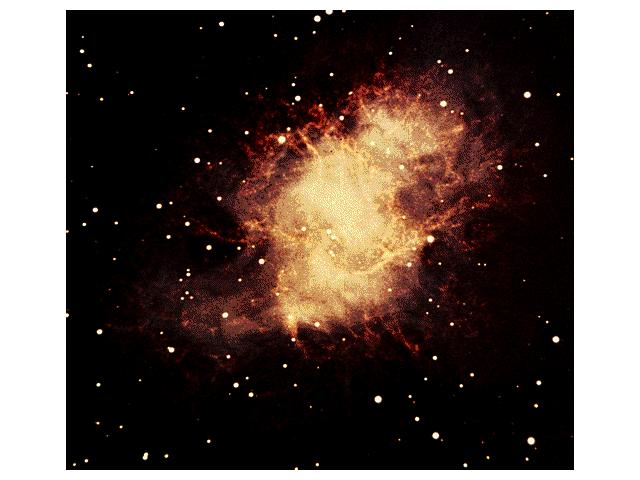 Vela SN Remnant: 9000 B.C. (Stone Age) As bright as the Moon for several months!!!! (only 500 pc away)
Observable SN should happen each century in our galaxy. We've
not seen any in modern times. This is because of interstellar
extinction due to dust in the Galaxy (recall the dust lanes across the
center of the Milky Way).
Vela SN Remnant: 9000 B.C. (Stone Age) As bright as the Moon for several months!!!! (only 500 pc away)
Observable SN should happen each century in our galaxy. We've
not seen any in modern times. This is because of interstellar
extinction due to dust in the Galaxy (recall the dust lanes across the
center of the Milky Way).
Concept Question 1:
The Sun will not die by going supernova because
- the Sun is the Sun, and it will never die.
- it is too hot.
- it is too large.
- it is too massive.
Concept Question 2:
Stars go supernova when they begin to burn
- hydrogen.
- helium.
- carbon.
- iron.
Concept Question 3:
Iron sets off the supernova explosion because
- it is the lightest element that absorbs energy when it fuses.
- it's dark in color, so it absorbs the light.
- it's magnetic.
- heavier elements decay radioactively into iron.
Concept Question 4:
Photodisintegration is
- when light is disintegrated by running into matter.
- when nuclei are disintegrated by light running into them.
- when stars are torn apart by light.
- when photographs turn brown and nasty over a long period of time.
Concept Question 5:
If all the heavy elements are torn apart in the supernova explosion, where did we get all of the elements in our bodies and on the Earth?
- They were made in the exploding material.
- They come from the collisions of galaxies.
- They come from the collisions of stars.
- They formed in the Big Bang, and have been there ever since.
Concept Question 6:
Degenerate materials...
- Can cool without shrinking.
- Don't obey the ideal gas law.
- Are as dense as they can be without exploding.
- All of the above.

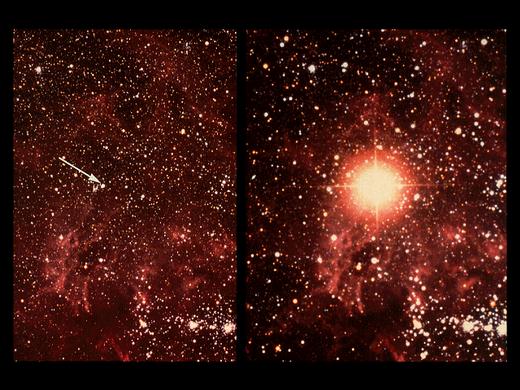
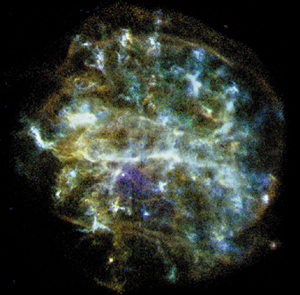
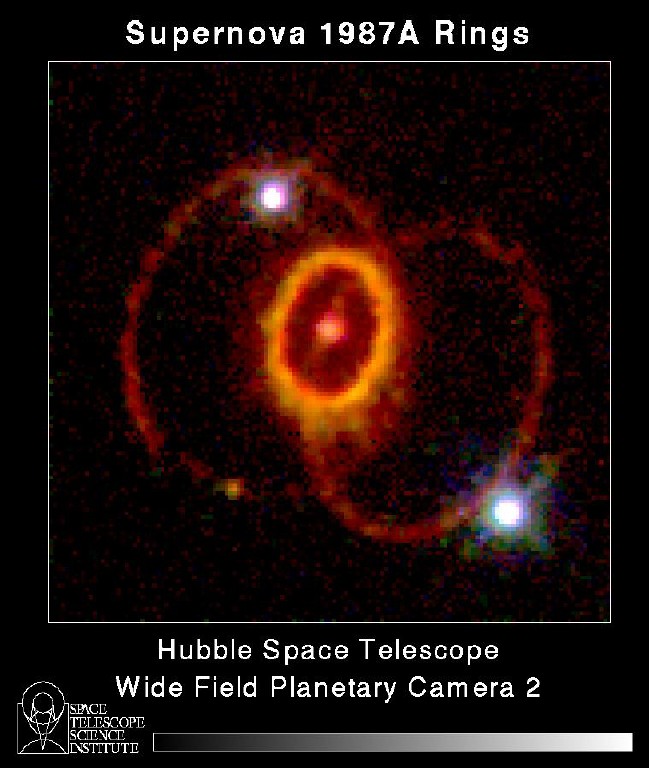

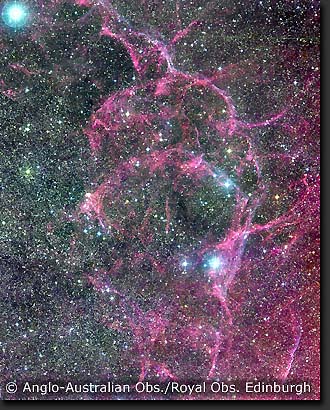






 The outer layer is a non-burning hydrogen envelope. Inside of this is a
hydrogen burning shell, then a helium burning shell, then carbon, then
oxygen, neon, magnesium, and silicon. In the center of it all is a core
of iron ash. Iron is special. It is the lightest element for which
fusion absorbs energy rather than releasing it. In other words, it
takes more energy to cause iron to fuse than comes out in the reaction.
Once the iron ignites, the gas will cool, because the burning iron will
take heat out of the system!
The outer layer is a non-burning hydrogen envelope. Inside of this is a
hydrogen burning shell, then a helium burning shell, then carbon, then
oxygen, neon, magnesium, and silicon. In the center of it all is a core
of iron ash. Iron is special. It is the lightest element for which
fusion absorbs energy rather than releasing it. In other words, it
takes more energy to cause iron to fuse than comes out in the reaction.
Once the iron ignites, the gas will cool, because the burning iron will
take heat out of the system!  Vela SN Remnant: 9000 B.C. (Stone Age) As bright as the Moon for several months!!!! (only 500 pc away)
Observable SN should happen each century in our galaxy. We've
not seen any in modern times. This is because of interstellar
extinction due to dust in the Galaxy (recall the dust lanes across the
center of the Milky Way).
Vela SN Remnant: 9000 B.C. (Stone Age) As bright as the Moon for several months!!!! (only 500 pc away)
Observable SN should happen each century in our galaxy. We've
not seen any in modern times. This is because of interstellar
extinction due to dust in the Galaxy (recall the dust lanes across the
center of the Milky Way).